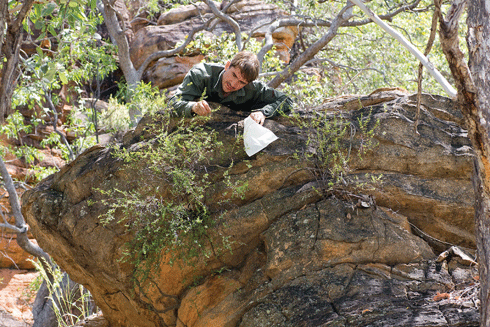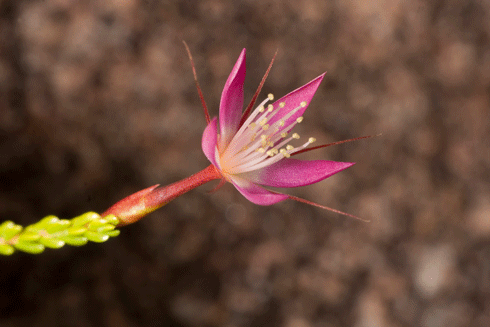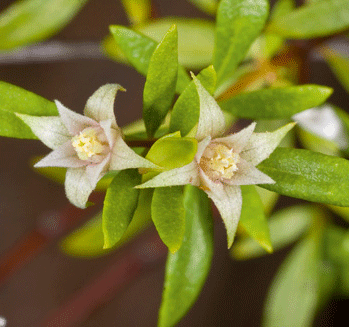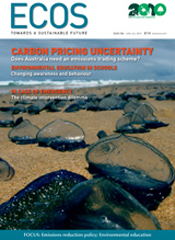
|
Published:
‘Hundreds’ of Kimberley plant species await discovery
The recent discovery of more than 10 new plant species in the remote Kimberley region of Western Australia has brought a ray of hope to environmental scientists in the International Year of Biodiversity.

|
|
Russell Barrett collects seed from a new species of cliff-dwelling boronia. Credit: Matt Barrett
|
Botanists and brothers, Matt and Russell Barrett – who grew up in the Kimberley, and now work for Perth’s Kings Park Botanic Gardens and Parks Authority – discovered the species during a one-week expedition in March.
Using Google Earth, they targeted prospective plant hotspots in the rugged Prince Regent River and Mitchell Plateau area and then explored them by helicopter.
Due to its inaccessible terrain and seasonal downpours, the Kimberley is one of the few areas in Australia to escape the wave of native species extinctions that followed European settlement.
However, this biodiversity needs to be protected from future human activity, particularly mining operations. The area, which is home to Rio Tinto’s Argyle diamond mine, is dotted with mineral leases.
As Russell Barrett explains, Prince Regent River’s unique topography – steep gorges, large flat mesas, and cliffs that drop vertically for hundred of metres – has so far acted like a fortress, protecting plants from mining activities and invasive species.
‘It’s one of the most dissected landscapes in the state, and the mesas have been isolated from each other for a long time, creating a diversity of species,’ he says.
Barrett says about 3000 known plant species have been identified from the Kimberley – an increase of 1500 from when Kings Park scientists started exploring the area in the 1980s – but there are possibly hundreds more yet to be discovered. Barrett suspects there are at least 1200 species in the Prince Regent River area alone.
As this part of the Kimberley is too inhospitable for human settlements, it has no rainfall gauges. However, estimates put annual rainfall at 1600 mm or higher, making it one of the state’s wettest areas.
In the dry season, in the deeply incised gorges of the region, moist refuges are available for rainforest plants.
‘People tend to think of the Kimberley as arid – most of them only drive there during the dry season, along the dusty Gibb River road,’ says Barrett. ‘But there are plenty of unique and unusual rainforest pockets off the beaten track.’

|
|
A delicate flower of a Kimberley rock myrtle (Calytrix sp.). By collecting plants during the wet season, the botanists were able to find many species in flower. Credit: Russell Barrett
|
The Barrett brothers have been researching plant species in the Kimberley for the past 15 years, adding more to the knowledge about plant species in the area than any other botanists in recent history.
The new plants include species from Acacia, Hibbertia, Melaleuca, Boronia, Triodia (spinifex), Solanum (bush tomatoes) and Eucalyptus.
Among them is a cliff-dwelling boronia, a form previously unknown in the Kimberley but known in Arnhem Land and Kakadu. By using Google Earth to locate habitat similar to that seen in Kakadu, the brothers were able to target likely habitat on cliff faces.

|
|
A close-up of the cliff boronia, which the Barrett brothers discovered using their botanical instincts, Google Earth and a helicopter. Credit: Russell Barrett
|
Some of the species they have found can only be found in tropical Queensland or Indonesia. As Barrett says, ‘it’s a fascinating mystery how they got to the Kimberley’.
Kings Park, which funded the trip, will now work to identify, record, propagate and further research the new species.
Kings Park Science Director, Dr Kingsley Dixon, refers to the Kimberley as ‘the last great botanical frontier in Australia’.
‘As new discoveries like these occur, the threats that undermine the Kimberley region are increasing, so if we don’t move quickly we may never know what we end up losing,’ he says.



